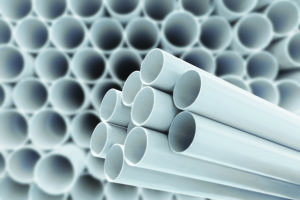Piping systems are meticulously designed with operating conditions in mind. To function properly, they need to be made from materials that can handle the pressure demands, temperature fluctuations, and any hazards the materials within may bring. Copper, PVC, CPVC, and cast iron are all common materials used in pipe manufacturing.
From their flow paths to the materials used, it’s important to ensure the pipes can meet the demands of the application. Polyvinyl chloride, known as PVC, is widely known as the revolutionary plastic used to make pipes. Rigid PVC is hailed for its chemical resistances and weldability. However, its lesser-known cousin, CPVC, comes equipped with a host of other qualities for more demanding needs. Which one is better will depend on the operating conditions of the application.
Understanding PVC
PVC, chemically known as Polyvinyl Chloride, is an amorphous thermoplastic material widely known for its impact strength and chemical resistance. It is a well-known replacement for copper, stainless steel, and iron in pipe manufacturing. It can resist oxidation or deterioration when exposed to various substances due to its molecular makeup.
PVC plastic is hailed for its moisture resistance, strength, and chemical properties. With service temperatures ranging up to 140°F (60°C), it is frequently used in waste and drainage systems, as well as recreational piping systems. While there are a variety of grades available, not all PVC pipes are good for potable water. Also, hot water applications may require a more resilient material.
Understanding CPVC
CPVC, also known as Chlorinated Polyvinyl Chloride, is PVC material infused with chlorine additives. The chlorine contents in CPVC pipes and fittings broadens the material’s capabilities and improves safety measures in various applications.
Adding chlorine enhances chemical properties and can improve operating capabilities under high heat and pressure. It also resists oxidation far better than standard PVC, allowing for a much longer service life. The result is a more resilient form of PVC. The chlorine additives give the material a way to resist harsher substances and prevent biofilm formation. The chlorine atoms can also allow the material to operate in temperatures up to 200°F (93.3°C).
PVC vs CPVC: Similarities and Differences
When comparing CPVC vs PVC, there are a host of similarities and differences. While they could be used interchangeably in some cases, there are also many use cases where one is better than the other. Adding chlorine may sound simple, but it could be the defining factor in which material provides optimal performance.
Similarities
- Both materials are commonly found in plumbing, irrigation, and water delivery applications.
- Both feature corrosion resistance and can handle exposure to various chemical substances.
- Both are lighter, durable alternatives to metal pipes.
- Both have ANSI/NSF-certified grades (see Data Sheets for more information).
Differences
- CPVC is chlorinated (infused with chlorine), PVC is not.
- PVC pipes are sized according to the Nominal Pipe Size (NPS) measuring system. CPVC can be sized according to NPS or CPS (Copper Pipe Size) system.
- Although both feature great chemical resistances, CPVC can handle exposure to a wider range of acids, alkalis, and other hazardous substances.
Which Is the Better Option?
While both materials may seem similar, the addition of chlorine can heavily influence which is better for your application. Generally speaking, PVC is cheaper, and can satisfy most recreational/commercial needs. Its service temperature range and chemical resistances are enough to cover most applications revolving around sewage, drainage, and other cold-water applications.
CPVC is generally more expensive, but comes with a host of enhancements that make it better for more demanding applications. When comparing PVC vs CPVC pipes, CPVC can be used in a broader range of operating conditions. It can be used for hot and cold-water applications. Its UV-stability also makes it optimal for indoor and outdoor needs.
Aside from operating conditions, one of the major factors when choosing which material is best is the contents involved. Both types of pipes have a host of chemical resistances, but each material may handle certain chemicals better than the other. CPVC is generally better when acids and hazardous materials are involved, but there may be some exceptions. For example, PVC is better in applications involving ammonia due to chlorine’s interactions with it. Polymershapes experts can help with the material selection process.
Browse Our PVC and CPVC Options
Investing in the right material is crucial for ensuring the long-term integrity of the piping system. Finding a material that can withstand the constant pressure demands and not react to the contents promotes safety and maximizes part life. Both PVC and CPVC are popular plastic options with proven performance and reliability.
Polymershapes is North America’s leading distributor of both CPVC and PVC material. Manufactured by trusted brands such as SIMONA, Palram, and Rochling, our locations have the best material solutions available. To learn more about our options, contact one of our experts today.
